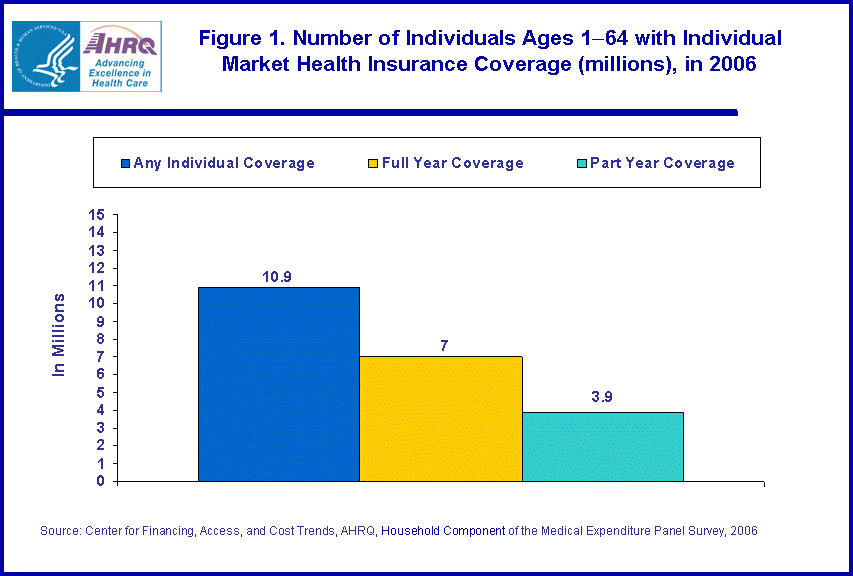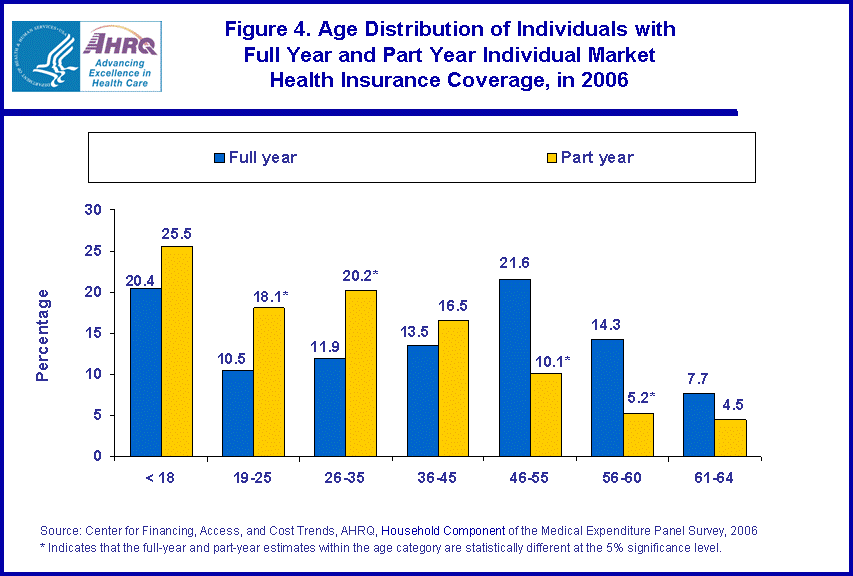
|
|
Font Size:
|
||||
|
|
|
|
||||
STATISTICAL BRIEF #227:
Length of Coverage in the Individual Health Insurance Market for the Non-Elderly U.S. Population, 2006
Highlights
- Nationwide, 10.9 million non-elderly individuals were covered by individual private health insurance for at least one month during 2006, 7.0 million were covered for the full year, and 3.9 million were covered for part of the year.
- In 2006, 64.1 percent of individuals with individual health insurance had such coverage for the full 12 months and the remaining months were distributed evenly from 1 to 11 months.
- Individuals with part-year individual health insurance coverage were more likely to be between the ages of 19 and 35 than those with full-year coverage. Alternatively, those with full-year individual health insurance coverage were more likely to be between the ages of ages 46 and 60 than those with part-year coverage.
- Of those who obtained part-year individual health insurance, 43.9 percent were able to obtain health insurance from other sources that provided them with 12 full months of health coverage.
Introduction
Health insurance coverage that people obtain outside the workplace is often referred to as individual health insurance. This type of coverage can be obtained directly from insurance companies or through groups such as associations, schools or other organizations. Individual health insurance is the main source of health insurance for Americans who are not eligible for employer-sponsored coverage or public health insurance. In 2006, 10.9 million non-elderly individuals under age 65 were covered by individual health insurance at some point during the year. Using data from the Household Component of the Medical Expenditure Panel Survey (MEPS-HC), this Statistical Brief examines the population with individual health insurance in 2006 and those with full-year and part-year individual coverage.
The non-elderly population in this Statistical Brief consists of those individuals under age 65 who were in the civilian noninstitutionalized population for the full calendar year and therefore excludes newborns and individuals who died or were institutionalized during the year. All differences between estimates discussed in the text are statistically significant at the .05 level unless otherwise stated.
Findings
Nationwide, 10.9 million non-elderly individuals were covered by individual private health insurance for at least one month during 2006, 7.0 million were covered for the full year and 3.9 million were covered for part of the year (figure 1). These figures represent a small proportion of the non-elderly population. Only 4.3 percent of the non-elderly population had individual private coverage at some point during 2006, 2.7 percent had full-year individual coverage and 1.5 percent had part-year individual coverage (figure 2).
Figure 3 shows the distribution of the number of months of coverage for the 10.9 million individuals with individual health insurance at some point during the year. As seen in figure 3, 64.1 percent of individuals had individual coverage for the full 12 months and the remaining months were evenly distributed from 1 to 11 months.
Figure 4 shows the age distribution for persons covered by individual private health insurance for the full year and for part of the year. Individuals with part-year individual coverage were more likely to be between the ages of 19 and 35 than those with full-year individual coverage. Those with full-year coverage were more likely to be between the ages of 46 and 60 than those with part-year coverage. For example, 18.1 percent of those with part-year coverage were 19-25 years old compared to 10.5 percent of those with full year coverage. In contrast, 21.6 percent of those with full year coverage were aged 46-55 compared to 10.1 percent of those with part-year coverage.
Table 1 provides additional information on individuals with part-year individual coverage. The average length of coverage for those with part-year individual health insurance was 5.9 months. Of those who obtained part-year individual health insurance, 43.9 percent were able to obtain health insurance from other sources that enabled them to have coverage for a full 12 months. Most of this coverage came from employers--40.1 percent of those with part-year individual coverage had full-year coverage through a combination of their individual health insurance and employer-provided coverage. In fact, 9.8 percent of individuals with part-year individual coverage (about one-quarter of the 40.9 percent with some employer provided coverage) had employment-related coverage for the full year.
Data Source
The analyses in this brief are based upon data from the MEPS 2006 Full Year Consolidated Data File: HC-105. These data are available at http://www.meps.ahrq.gov.
Definitions
Age
Age is defined as age at the end of 2006.
Individual Health Insurance
Individual health insurance was defined as private health insurance that was obtained from sources other than an employer or union, including coverage from some other group, such as an association, as well as from non-group sources, such as an insurance company or HMO and coverage identified as being obtained by self-employed individuals with no employees.
Employment-related Health Insurance
Employment-related coverage was defined as including health insurance obtained through an employer or union, through someone outside of the household or whose source was unknown.
About MEPS-HC
MEPS-HC is a nationally representative longitudinal survey that collects detailed information on health care utilization and expenditures, health insurance, and health status, as well as a wide variety of social, demographic, and economic characteristics for the civilian noninstitutionalized population. It is cosponsored by the Agency for Healthcare Research and Quality and the National Center for Health Statistics.
References
For a detailed description of the MEPS-HC survey and sample design, and methods used to minimized sources on nonsampling error, see the following publications:
Cohen, J. Design and Methods of the Medical Expenditure Panel Survey Household Component. MEPS Methodology Report No. 1. AHCPR Pub. No. 97-0026. Rockville, MD: Agency for Health Care Policy and Research, 1997. http://www.meps.ahrq.gov/mepsweb/data_files/publications/mr1/mr1.shtml
Cohen, S. Sample Design of the 1996 Medical Expenditure Panel Survey Household Component. MEPS Methodology Report No. 2. AHCPR Pub. No. 97-0027. Rockville, MD: Agency for Health Care Policy and Research, 1997. http://www.meps.ahrq.gov/mepsweb/data_files/publications/mr2/mr2.shtml
Cohen, S. Design Strategies and Innovations in the Medical Expenditure Panel Survey. Medical Care, July 2003: 41(7) Supplement: III-5-III-12.
Suggested Citation
Vistnes, J. Length of Coverage in the Individual Health Insurance Market for the Non-Elderly U.S. Population, 2006. Statistical Brief #227. December 2008. Agency for Healthcare Research and Quality, Rockville, MD. http://www.meps.ahrq.gov/mepsweb/data_files/publications/st227/stat227.shtml
AHRQ welcomes questions and comments from readers of this publication who are interested in obtaining more information about access, cost, use, financing, and quality of health care in the United States. We also invite you to tell us how you are using this Statistical Brief and other MEPS data and tools and to share suggestions on how MEPS products might be enhanced to further meet your needs. Please e-mail us at mepspd@ahrq.gov or send a letter to the address below:
Steven B. Cohen, PhD, Director
Center for Financing, Access, and Cost Trends
Agency for Healthcare Research and Quality
540 Gaither Road
Rockville, MD 20850
|
||||||||||||||||||||||||||||||||||||||||
|
|
||||||||||||||||||||||||||||||||||||||||
 |
||||||||||||||||||||||||||||||||||||||||
|
||||||||||||||||||||||||||||||||||||||||
|
|
||||||||||||||||||||||||||||||||||||||||
 |
||||||||||||||||||||||||||||||||||||||||
|
||||||||||||||||||||||||||||||||||||||||
|
|
||||||||||||||||||||||||||||||||||||||||
 |
||||||||||||||||||||||||||||||||||||||||
|
||||||||||||||||||||||||||||||||||||||||
|
|
||||||||||||||||||||||||||||||||||||||||
 |
||||||||||||||||||||||||||||||||||||||||
|
||||||||||||||||||||||||||||||||||||||||
|
|
||||||||||||||||||||||||||||||||||||||||


